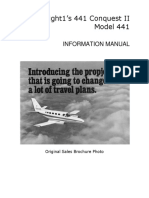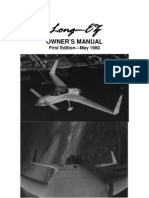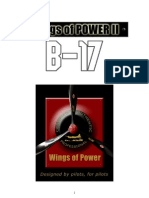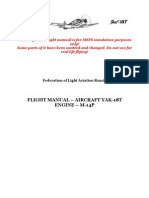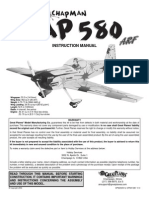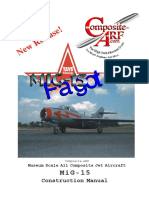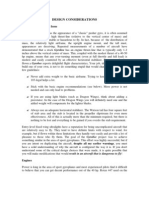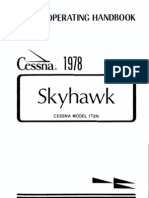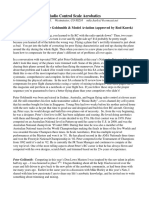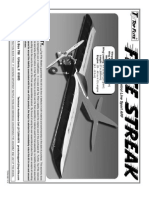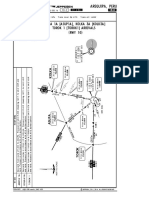72 Yak 54 Manual
72 Yak 54 Manual
Uploaded by
peng_dongtao2054Copyright:
Available Formats
72 Yak 54 Manual
72 Yak 54 Manual
Uploaded by
peng_dongtao2054Copyright
Available Formats
Share this document
Did you find this document useful?
Is this content inappropriate?
Copyright:
Available Formats
72 Yak 54 Manual
72 Yak 54 Manual
Uploaded by
peng_dongtao2054Copyright:
Available Formats
Quiques Signature series 72 YAK 54
The flying manual
Thank you for purchasing the most exiting aerobatic airplane of this class. This 72 YAK 54 is a scaled down version of the YAK-54 TOC model that my friend and partner Wayne Ulery built and I used to compete and win competitions such as the Don Lowe Masters 2003, the Free Style World Championships 2003 in Lakeland Florida and 3rd place at TOC 2002 in Las Vegas. I have also performed with the TOC model at several air shows. I have designed this airplane to perform unlimited aerobatics in two styles of flying, precision (Aresti) and 3D. The airplane design and set up was accomplished around challenging compromises required to perform best at the extremes of all aerobatics. All of the equipment used including, engine, prop, fuel, servos, CG location, rates, etc, have been chosen with the only purpose to perform well at all types of aerobatics and not specifically to just one segment. This 72 Yak-54 it is not just a fun fly aircraft type and it not just a precision pattern airplane, it is both and believe me will do the jobs of both, of course with the support of your flying skill! With this manual I want to help you out as much I can in order to in-able you set up your airplane with the finest control adjustments and best flying conditions under all of the aerobatic spectrums. Ive learned after more than 25 years competing at the international level that setting up an airplane is almost as important as the design it self in order to get out the very best performance from the airplane and that is what you to accomplish. To get the very best performance of an airplane it takes a lot of flying time in order to test it under different conditions and always there are things better to test and try, so my proposal for you is to keep you updated at www.somenzini.com with my latest set up configurations in order for you to get the best performance of your Yak-54, 140. Any new set-ups or adjustments that I have made and/or tested and find to be an improvement will be posed for you at our web site. EQUIPMENT SELECTION As with any aerobatic airplane the engine selection it is always a key element for the top performance of the airplane. The engine needs to be powerful enough in order to make this Yak-54 the airplane of your dream! But in aerobatic maneuvers power it is not all that you need, youll need also go od throttle response and transition as well as good idling. The 72 Yak-54 has been designed to do unlimited, Aresti and 3D aerobatics, so for this very wide range of aerobatics without question you need a good engine. With
your Yak you will be performing maneuvers close to the ground that will depend on the engine such as in a torque roll so you need an engine that you can trust too. Power it is very important in order to do this wide range of aerobatics. On my 72 Yak-54, I am running a YS-140 sport, turning an APC 17x8 here at 900 feet above sea level and under 90 degrees F and about 80% humidity. I have enough power to climb with authority from the hovering position. In case of the YS engines they may be the best option for those who fly at high altitude because of the supercharged system. However there are many other engines that could do good job like the Saito 1.80 Golden knight, OS 1.60/1.40, Webra 1.20/1.45/1.60, etc. The airplane has been designed to handle glow engines from 1.2 to 1.8. With this range of engines size the airplane should have the right balance for CG and wing loading, so please do not run gas power engines on this airplane. For those of you that fly at high altitudes, 3,500 feet and up I will recommend that you run the largest engine for this airplane. An increase in the amount of nitro in the fuel will be a help too. As I mentioned before probably the best option will be the YS engines with the supercharged system. And if you choose a YS 1.40 or 1.60 DZ they will give the punch that you will need. The altitude, temperature and humidity has a big influence over the performance of the engines, props and airplane, so be prepared that your airplane will loose performance especially if you are flying in the middle of the summer at high altitude. Do not expect the same performance as it would have at sea level. The prop it is a very important element, so take special attention to choose the best prop size. I would like to give you a small chart to choose the best starting point prop for your engine, I say starting point because the prop size can vary on the fuel, altitude, temperature and humidity that you use and fly. I like to run my YS engines on Cool Power heli 30% nitro. In case of other engines brands please follow the manufacturers instructions. Again your choice of a given prop size is always a compromise to fly best precision and 3D. YS 1.20 APC 15X8 YS 1.40L APC 17X8 -18x6W YS 1.40 SPORT APC 17x8 - 18x6W YS 1.40 DZ APC 17X10 18X8 YS 1.60DZ APC 18X10 18x8W Saito 1.80 GK APC 17X8 16X8/10 OS 1.40 RX APC 17X10 OS 1.60 APC 18X8-18X8W WEBRA 145 APC 17X8-18X8 Your choice of servos is always important on any aerobatic airplane. The power that it takes to move the control surfaces with authority some times goes beyond our best guess! I will strongly recommend that you run a good quality servo with output power above 90 oz. of torque and ball bearing style. If you have some digital servos do not hesitate to use them, they will give extra ordinary response. I have in my airplane the JR8411SA digital servo on 4.8 volts giving a solid 125oz. of torque. If you use weaker servos (under 90oz) you are risking your 72 Yak-54, to a potential crash due to flutter on any of the control surfaces which of course will produce the total destruction of the airplane. The large area
of the control surfaces and the long arms on the servo takes a lot of abuse on servo, so I strongly recommend yo u do not run cheap or weak servos. This is on the safety side, on the flying side, with powerful servos you will enjoy much more the flying, feeling the total control of the airplane under any maneuver with no limitations. About transmitter, please read the radio set up section. BASIC SET UP The basic set up is all about the airplane itself, this does not include the radio programming which will see later. All the incidence, wing, stab and engine have been already set by our factory and no changes need to be made. The center of gravity as on any airplane is VERY IMPORTANT, I will strongly recommend you to check very carefully the following measurement, 387mm (15-1/4) from the back of the canopy as it is shown in the pic. #1 a & b with the airplane ready to fly and put together, less canopy hatch and fuel, at this position it should balance at flight line attitude (hatch line at zero). Check pic. #2.Please also look pic.#3 this is a good and precise way to measure the CG, it is a piece of dowel 125mm (5) long and 7mm in dia. (1/4) that slide under the top fuse former, to then lift the airplane from it. At this CG location I did find it to be the best for this airplane to perform both the precision and the 3D aerobatic. All the incidences, the throws and all explained in this manual are going to be changed if this CG location is changed, so I strongly recommend that you do not shift it. The 72 Yak-54 responds extremely well to all flying surfaces and it is not only because of the CG location, it is also due to the clean fuselage, wing and stab airfoil and the generous control surfaces. This is important to understand and for that reason I would like to provide you with the best electronic rate when you program your radio for each maneuver, the best clevis location at the control horn and servo horn, to have the best and most accurate deflection of each flying surface. SERVO CONNECTION The 72 Yak-54 has two servos per aileron and two servos per elevator, then the rudder and throttle. The aileron servos need to be plug into different channels, so the right aileron will be connected to the aileron channel and the left aileron will be connected to the flap channel for JR, in case of Futaba connect to channel 7. The elevator servos need to be connected to different channels also, the right elevator will be connected to the elevator channel and the left will be connected to the AUX3 channel for JR, Futaba will be the gear channel. Depending on your radio brand and type youll need to activate the functions to make the aileron servos to travel in the right direction and simultaneous as well for the elevator servo. In case of JR 10X the function is #22 called Flaperon for aileron and tail dual servo, Futaba 9zap uses differential function for aileron and elevon for elevator. In case that you do not have the top of the line radio and you are missing one or both of these functions you can program your mixing function. Of course the rudder and throttle servo will be connected to their channels.
HOOKING THE AILERONS TO THE SERVOS Use the long servo control horn provided by your servo manufacturer, connect the clevis at the outer hole, to be more precise measuring from the center of the servo output to the outer hole should be 15mm (5/8) At the aileron horn, use the horn provided with the kit and connect the other end clevis in the 3rd hole counting from the base of the horn. It is important as it is shown in the instruction manual to locate this horn with the edge of the base just next to the edge of the aileron. Also make sure the aileron sub trim and trim at your radio program are at zero. Once it is at zero install the servo horn to be perpendicular to the main servo axis. If you find the servo horn is not perfectly perpendicular slightly adjust with the sub trim of your radio. Once all of this is done, adjust the clevis to the proper length to set the aileron surface at a perfectly neutral position and connect the end clevis to the position described before. Do same thing with both wing panels. It is very important both ailerons travel the same distance up and down, if not it is called aileron differential. In the case of this 72 Yak-54 it will not need any differential, so make sure that both ailerons are traveling the same distance up and down. If the ailerons are not traveling same, then the aileron rolls will not be clean and axial and will look more like barrel rolls. Try to measure at highest rate and if you find any difference, use the travel rate function at your radio. Remember it is important to have the servo arm perpendicular to the main axis of the servo and the sub trim and trim of your radio at zero; this will make the job simpler. HOOKING THE ELEVATORS TO THE SERVOS Install the servos and connect to their respective channels as was suggested on servo connections. Set the sub trims and trim at zero and install a servo horn perpendicular to the main servo axis with a length of 25 mm (1) from the center of the servo output to the hole where the rod will be connected. Installed the control horn supplied with the kit on the elevator as was suggested in the instruction manual and connect the other end of the clevis to the 3rd hole counting from the base of the horn. Adjust the rod to the right length in order to set the elevator at neutral position. It is important that both halves of the elevator travel the same up and down, because if they dont, your airplane will not track straight at corners. Best way to check if the elevators are traveling the same it to measure at the counter balance leading edge. Make sure both halves travel the same and both have same amount up and down. If there is any difference on the travel use the travel adjustment functions. Some times the travel adjustment function will not be as perfect as needed, so then use the sub trim to offset a bit at neutral position and re-adjust the rod to the right length to keep the elevator at neutral position. By playing with this you will learn which is the best direction and the amount needed. You will be surprise how much influence a small amount off at center will affect the performance. HOOKING THE SERVO TO THE RUDDER Connect the servo to receiver and set subtrim and trim to neutral position, install a long servo arm as provided by the servo manufacturer, perfectly perpendicular to the main servo axis. Install on the rudder surface the control horns provided with the kit and as indicated in the instruction manual. Connect the pull/pull cables to the outer holes at the servo horn to be more precise at 15mm (5/8) from the center of the servo output. Then connect the other ends to the 3rd hole of each control horn counting from the base of the horn. Adjust the cables in order to set the rudder at neutral position. In any case the servo
horn is not perfectly perpendicular to the main servo axis, adjust that difference with the use of the subtrim and before you adjust the pull/pull cables. After you fly the airplane for 3 to 5 flights you will need to readjust the cables because they will get to their place. After that check the cables every 50 flights or so. On the rudder we need the strongest servo; this is the most demanding command on an airplane. Also with the pull/pull system a ball bearing servo will help, please read at servo selection. HOOKING THE SERVO TO THE THROTTLE Nothing is different here from what youve been doing but a few things to look at. Try to have similar number (%) at your high and low throttle settings. If these numbers are not similar then your throttle response will change. For that try to set the carburetor barrel at middle range, then set your throttle stick at center, then adjust the top and bottom end, ideal % will be if you are like 100% for full open and 100% for idle with trim at center. To reach that 100%, play with the clevises position at the throttle barrel or servo horn. With the trim at center then you can kill the engine by shifting the throttle trim to full down position. At this value the throttle will be lineal, then if you do not like how the engine responds, use the throttle curve function if your TX program has it. My personal feeling on this is to not use throttle curve as I like to feel the engine how it is with out any electronic feeling in between. Advise, use a good quality servo for the throttle, I have seen many crashes because throttle servo did fail. You know accidents happen when something fails more than how it fails, so thinking your throttle servo it is as important is any other servo on board of your airplane you will reduce the risk of an accident. RADIO SET UP Radio set up is a very important side of the airplane set up for the very top performance. All of the mechanical and aerodynamic adjustments have been done, and please keep in mind if you change any of this mechanical value all the electronic value will change, so lets have a look to the radio programming. The 72 Yak-54 has been designed to be controlled with a simple radio system, expensive radio equipment will not be required however if you want the very finest tuning you might need it. After you do the servo connection as I described above, you will need to adjust the rates. For that I suggest for you to adjust all servo travel to full position. I have given you above the servo size arm and the clevis position at the control horn; however different radios will give you different travel so to avoid mistakes I would like to talk about the measurements at the airplane rather than percentage. While you adjust the maximum traveling for each servo (rudder, elevator and aileron) you are adjusting the high rate that you are going to need to do the 3D aerobatics. So go and check the following values. Elevator, measuring at stab counter balance as its shown pic. #4 a & b you should have 74mm (2-15/16) up and down. Aileron, measuring at the aileron root as it is shown pic. #5 a & b you should have 45mm (1-3/4) up and down. Please remember that both ailerons should move same up and down. Rudder, measuring at the counter balance as it is shown in the pic. #6 a & b you should have 63mm (2-1/2) right and left.
Once you finish with the maximum rate adjustments, it will be the time to adjust the low rate. The low rate value is the one that you will use for all your flying except the 3D, these values that I am going to recommend to you are good compromising numbers to balance best with minimum radio programming set up for all spectrum of the Aresti maneuvers. Elevator, measuring at stab counter balance as its shown pic. #4 a & b, you should have 12mm (1/2) up 10mm (25/64) down Aileron, measuring at the aileron root as its shown pic. #5 a & b, you should have 30mm (1-3/16) up and down. Please remember to check both ailerons so they are traveling the same distance up and down. Rudder, measuring at the counter balance as it is shown pic. #6 a & b you should have 34mm (1-11/32) right and left. Now that you have adjusted the high and low rate let me gave you the exponential that I found best at high and low rate. High rate exponential Elev. 80%* Rudder 45%* Ail. 70%* Low rate exponential 55%* 15% * 55% *
*I have not put any symbols (+ or-) because depending on the radio brand that you fly this symbol can have a different meaning. The type of exponential that I am suggestion to you is the one that reduces the sensitive feeling around neutral stick position, in other words makes softer feeling to the airplane. Mixing The 72 Yak 54 requires none or very little mixing and the only mixing that I am using on mine is the rudder to elevator in order to keep the airplane tracking perfectly straight at knife edge position, without going to the belly or canopy at that position. The mixing it is very small. If you have mixing curve in your transmitter it is what I am using to fine tune the airplane along all the rudder stick deflection. Under this type of mixing I am running from neutral up to 75% right rudder stick deflection 0% mixing, from 75% stick deflection to full 3% up elevator mixing. On left rudder I am running from neutral to 50% stick deflection 0% mixing and from 50% stick deflection to full only 1%. If you do not have mixing curve type, use the regular mixing program and mix only 2% to the right and 0% to the left, this will work best as a compromising point. Flying!! If you have followed the assembly manual and this flying manual your airplane should be ready to go to perform the most exiting aerobatics that you ever experienced!, so prepare your self to enjoy one of the best aerobatic airplanes of the world!!!. Let me give you some tips how to control your rates at different maneuvers, this is important to know because if you try to do a maneuver with the wrong rate the airplane simply will not do it.
Aresti Maneuvers Take off / landings Elev. low rate Ail. Low rate Rud. High rate Snap roll Elev. low rate Ail. Low rate Rud. Low rate Stall turn Elev. Low rate Ail. Any Rud. High rate Rolling circle/ rolling loops Elev. Low rate Ail. Low rate Rud. High rate Knife edge loop/ knife edge pass by/ knife edge etc. Elev. low rate Ail. Low rate Rud. High rate Spins Elev. low rate Ail. Low rate Rud. High rate Loops/ corners/ lines Elev. low rate Ail. Low rate Rud. Any 3D maneuvers Torque roll/ panic/ cobra/ high alpha rolls/ waterfall/ wall/ terminator/ flat spin /reverse flat spin/ roller coaster/ pendulum/ high alpha rolling circle/ knife edge spin. Elev. high rate Ail. high rate Rud. high rate
Final Words I hope you have fun flying the 72 Yak-54; it has been fun for me during all the testing period. It responds extremely fast to all flying surfaces, it is crispy and also smooth, with incredible similar flying characteristic to my TOC Yak-54. I believe with this airplane and for those of you who like to compete, you have in your hands an aircraft that has a unique precision and presentation that can you take you to the winners circle! Just practice hard and feel confident in your Yak-54 and your flying skills. Finally I would like one more time to thank you for purchasing one of our airplanes and one more time enjoy it and have fun! Sincerely yours,
QUIQUE SOMENZINI
CENTER OF GRAVITY
#1b
#1a
#2
#3
ELEVATOR, RUDDER AND AILERONS RATE
# 4 a Elevator
# 4 b Elevator
# 5 a Aileron
# 5 b Aileron
# 6 a Rudder
# 6 b Rudder
You might also like
- How to Rebuild & Modify Rochester Quadrajet CarburetorsFrom EverandHow to Rebuild & Modify Rochester Quadrajet CarburetorsRating: 5 out of 5 stars5/5 (2)
- Gyrobee PlansDocument131 pagesGyrobee PlansRichard Neville100% (10)
- 737 Performance Reference Handbook - EASA EditionFrom Everand737 Performance Reference Handbook - EASA EditionRating: 4.5 out of 5 stars4.5/5 (3)
- Supplemental Type Certificate NDocument32 pagesSupplemental Type Certificate Nlocoboeing100% (2)
- Flight1 441 Conquest User's Guide PDFDocument81 pagesFlight1 441 Conquest User's Guide PDFJosé A. Montiel Quirós100% (3)
- Manual For Magic Spirit Microlight TrikeDocument18 pagesManual For Magic Spirit Microlight TriketrojanburroNo ratings yet
- Bombardier BD-100-1A10 Challenger 300Document176 pagesBombardier BD-100-1A10 Challenger 300mustang12484100% (1)
- Pilatus-Pc7 ManualDocument19 pagesPilatus-Pc7 ManualRoderick Diaz MoraNo ratings yet
- Long-EZ POHDocument72 pagesLong-EZ POHDonald Foulk100% (4)
- Instruction Manual Twin Lobe CompressorDocument10 pagesInstruction Manual Twin Lobe Compressorvsaagar100% (1)
- ATP Cessna 172 Training SupplementDocument50 pagesATP Cessna 172 Training SupplementAbiy Tadese100% (4)
- C182P PohDocument93 pagesC182P PohDaniel GomezdelaVega100% (3)
- b17 ManualDocument33 pagesb17 ManualCristian Calvillo100% (2)
- RCV 4 Stroke EngineDocument13 pagesRCV 4 Stroke EngineeternalmanNo ratings yet
- Helicopter Maneuvers Manual: A step-by-step illustrated guide to performing all helicopter flight operationsFrom EverandHelicopter Maneuvers Manual: A step-by-step illustrated guide to performing all helicopter flight operationsRating: 5 out of 5 stars5/5 (1)
- Osprey - Aerospace - Desert WarpaintDocument130 pagesOsprey - Aerospace - Desert Warpaintpeng_dongtao2054100% (1)
- Yak-18T Flight ManualDocument47 pagesYak-18T Flight Manualpeng_dongtao2054No ratings yet
- An 2 ChecklistDocument18 pagesAn 2 Checklistpeng_dongtao2054100% (1)
- Airbus AI-PX7 CROR Design Features and Aerodynamics: Camil A. NegulescuDocument17 pagesAirbus AI-PX7 CROR Design Features and Aerodynamics: Camil A. NegulescuMani Rathinam RajamaniNo ratings yet
- RCGF Engine Operations ManualDocument8 pagesRCGF Engine Operations ManualricalvarengaNo ratings yet
- 60d1a18b-cb42-4fc3-a01c-49c9b37f5594Document8 pages60d1a18b-cb42-4fc3-a01c-49c9b37f5594Tarso BrasilNo ratings yet
- Great Planes CAP 580 - ManualDocument24 pagesGreat Planes CAP 580 - ManualjuansallasNo ratings yet
- 412 Tuning Tips 2Document7 pages412 Tuning Tips 2nikola parlov100% (1)
- Carf Mig15manualDocument75 pagesCarf Mig15manualricardoNo ratings yet
- Corsair InstructionmanualDocument45 pagesCorsair InstructionmanualJorge José Figueiredo SiqueiraNo ratings yet
- Gbeer 50Document132 pagesGbeer 50Audinda LeiniaNo ratings yet
- 30cc Yak 55 Redwing PDFDocument23 pages30cc Yak 55 Redwing PDFaero oranNo ratings yet
- 78" EXTRA 300 ARF: Instruction ManualDocument27 pages78" EXTRA 300 ARF: Instruction Manualsimonthierryhotmail.comNo ratings yet
- Assembly Manual: Semi Scale Yak-54S, ARF 85"Document48 pagesAssembly Manual: Semi Scale Yak-54S, ARF 85"mohamed sidkyNo ratings yet
- Extra300 88 ManualDocument39 pagesExtra300 88 ManualCarlos NakagawaNo ratings yet
- Spirit Elite ManualDocument24 pagesSpirit Elite ManualMoafarNo ratings yet
- Su 27 Instruction Manual Ver 1 4Document44 pagesSu 27 Instruction Manual Ver 1 4Duong MaiNo ratings yet
- Bell 412 Main Rotor NotesDocument5 pagesBell 412 Main Rotor NotesIbrahim KamalNo ratings yet
- Mini MB339 1,44m: ARF 90mm EDF-6S or P20-K30 TurbineDocument5 pagesMini MB339 1,44m: ARF 90mm EDF-6S or P20-K30 TurbineLava R5s2019No ratings yet
- Design Considerations: The Centerline-Thrust IssueDocument4 pagesDesign Considerations: The Centerline-Thrust Issueabit1962No ratings yet
- ARF 73in EXTRA330SC 120E & 30CC Manual (20150610)Document47 pagesARF 73in EXTRA330SC 120E & 30CC Manual (20150610)ricardoNo ratings yet
- Assembly Manual: Semi Scale Yak-54S, ARF 73"Document45 pagesAssembly Manual: Semi Scale Yak-54S, ARF 73"mohamed sidkyNo ratings yet
- Rv-9 n178tl Poh 01dec11Document36 pagesRv-9 n178tl Poh 01dec11Polkaboy2100% (1)
- Somethin Extra ArfDocument18 pagesSomethin Extra ArfYahya HassanNo ratings yet
- Cessna 172 NPOHDocument73 pagesCessna 172 NPOHYuandao WeiNo ratings yet
- Cessna 172 NPOHDocument73 pagesCessna 172 NPOH098zyxNo ratings yet
- Os Erj Legacy Operations ManualDocument26 pagesOs Erj Legacy Operations Manualednaus50% (2)
- Navaid Devices AP-1Document32 pagesNavaid Devices AP-1hbpanelaviationNo ratings yet
- P Goldsmith TrimmingDocument8 pagesP Goldsmith TrimmingShaunNo ratings yet
- Jpower Sky Surfer Arf Review: Jon R. BarnesDocument12 pagesJpower Sky Surfer Arf Review: Jon R. Barnesopenfalcon68No ratings yet
- Somethin Extra n477scDocument29 pagesSomethin Extra n477scYahya HassanNo ratings yet
- Hang Gliders Product InformationDocument20 pagesHang Gliders Product InformationJanardhan S IyerNo ratings yet
- E TRA ARF: Assembly ManualDocument32 pagesE TRA ARF: Assembly ManualCarlos NakagawaNo ratings yet
- American Champion Citabria 7-Series POH Newer)Document78 pagesAmerican Champion Citabria 7-Series POH Newer)mlc43No ratings yet
- Aeros BMW Manuale UsoDocument46 pagesAeros BMW Manuale UsoMirko CoppiniNo ratings yet
- Flight Streak ManualDocument12 pagesFlight Streak ManualJason StiehlerNo ratings yet
- T 28 Trojan Naval Aviation - 257Document20 pagesT 28 Trojan Naval Aviation - 257Giuseppe DNo ratings yet
- Manual - Quadcopters Review (Watermarked) PDFDocument28 pagesManual - Quadcopters Review (Watermarked) PDFQuads For Fun100% (3)
- P47 ManualDocument84 pagesP47 ManualFernando Costa E Silva100% (1)
- Gpma0492 Manual v1 1Document30 pagesGpma0492 Manual v1 1Marvin RoblesNo ratings yet
- Kawasaki VN800 GrampsizeDocument23 pagesKawasaki VN800 Grampsizetw4nnyNo ratings yet
- 91 Extra 300EXP ManualDocument31 pages91 Extra 300EXP ManualDragan SorinNo ratings yet
- How To Design and Build Your Own Airplane: Y'.' 3. Has The Best Possible Performance For The Power AvailableDocument2 pagesHow To Design and Build Your Own Airplane: Y'.' 3. Has The Best Possible Performance For The Power AvailablejustincosgroveNo ratings yet
- How To Make A Flight LogDocument3 pagesHow To Make A Flight LogBoris PetrovicNo ratings yet
- Gpma1220 1221 Manual 1Document24 pagesGpma1220 1221 Manual 1Antonio ManuelNo ratings yet
- A DIY'ers Definitive Guide to Building a Custom Volkswagen TrikeFrom EverandA DIY'ers Definitive Guide to Building a Custom Volkswagen TrikeNo ratings yet
- A013v1 ch10Document36 pagesA013v1 ch10peng_dongtao2054No ratings yet
- Chapter 3 - Automatic Flight Control System Chapter 3 - Automatic Flight Control SystemDocument32 pagesChapter 3 - Automatic Flight Control System Chapter 3 - Automatic Flight Control Systempeng_dongtao2054No ratings yet
- Chapter 21 - Water and Waste Systems Chapter 21 - Water and Waste SystemsDocument14 pagesChapter 21 - Water and Waste Systems Chapter 21 - Water and Waste Systemspeng_dongtao2054No ratings yet
- 35 31 Engine EGTDocument5 pages35 31 Engine EGTpeng_dongtao2054No ratings yet
- CJ6 Pilot ReportDocument8 pagesCJ6 Pilot Reportpeng_dongtao2054100% (1)
- Lycoming IO 360 M1ADocument40 pagesLycoming IO 360 M1Apeng_dongtao2054No ratings yet
- O-360 & Io-360 Series Engines Maintenance ManualDocument170 pagesO-360 & Io-360 Series Engines Maintenance Manualpeng_dongtao2054No ratings yet
- Da-42 AfmDocument332 pagesDa-42 AfmBlaž VerdevNo ratings yet
- Pilatus Pc-12 Sample Ops Manual DraftDocument101 pagesPilatus Pc-12 Sample Ops Manual Draftpeng_dongtao2054100% (1)
- Vortex Generator Installation Manual BaronDocument45 pagesVortex Generator Installation Manual Baronpeng_dongtao20540% (1)
- Bendix Aviation Corp., Pioneer Instrument DivisionDocument2 pagesBendix Aviation Corp., Pioneer Instrument Divisionpeng_dongtao2054No ratings yet
- CFI Level II FAA Study GuideDocument298 pagesCFI Level II FAA Study GuideSereth LoveNo ratings yet
- Adp IDocument110 pagesAdp IYashwanth yashuNo ratings yet
- AA 376/17 JAN/LAX-SLC: - Not For Real World NavigationDocument23 pagesAA 376/17 JAN/LAX-SLC: - Not For Real World NavigationHog FliesNo ratings yet
- Preface: Handbook (QRH) Is Not Normally Issued Concurrently WithDocument208 pagesPreface: Handbook (QRH) Is Not Normally Issued Concurrently WithKent100% (1)
- Acars Applis03part2 PDFDocument46 pagesAcars Applis03part2 PDFjjaavvmmNo ratings yet
- QRH 02-Aug-22Document154 pagesQRH 02-Aug-22aashesh puriNo ratings yet
- A320.Normal Procedures Self Study - lpc.V001.130101Document29 pagesA320.Normal Procedures Self Study - lpc.V001.130101Tony Paco100% (2)
- History: Avionics Is A Term Used To Describe All of TheDocument5 pagesHistory: Avionics Is A Term Used To Describe All of TheBhukya VenkateshNo ratings yet
- Sandel 3400Document119 pagesSandel 3400franjov22No ratings yet
- General Description: EC 135 Training Manual GeneralDocument132 pagesGeneral Description: EC 135 Training Manual Generalpilot digital100% (2)
- SPQUDocument14 pagesSPQUJohnny JosephNo ratings yet
- Boeing 747 Checklist: Preliminary Cockpit InspectionDocument2 pagesBoeing 747 Checklist: Preliminary Cockpit InspectionManishNo ratings yet
- Ata 22 (Auto FLT)Document400 pagesAta 22 (Auto FLT)Milad MohammadiNo ratings yet
- La Romana, Dom Rep MDLR/LRM: .Eff.13.SepDocument4 pagesLa Romana, Dom Rep MDLR/LRM: .Eff.13.SepVanessa YumayusaNo ratings yet
- MPTO Charts566662Document25 pagesMPTO Charts566662andres ortizNo ratings yet
- KT70-7 1 PDFDocument4 pagesKT70-7 1 PDFYogendra sharmaNo ratings yet
- Instrument Procedures HandbookDocument95 pagesInstrument Procedures HandbookCarlos AcuñaNo ratings yet
- Acceptance Manual Customer Flight CheckDocument19 pagesAcceptance Manual Customer Flight CheckLuis Enrique La Font FrancoNo ratings yet
- NACA 4 Digit Airfoil Generator (NACA 5412 AIRFOIL)Document2 pagesNACA 4 Digit Airfoil Generator (NACA 5412 AIRFOIL)eng1n1nj4No ratings yet
- Multi Engine Guide 04may2021Document95 pagesMulti Engine Guide 04may2021dennisNo ratings yet
- Jeppesen Airline Charts Series PDFDocument8 pagesJeppesen Airline Charts Series PDFJem ContrerasNo ratings yet
- Instructor Corner: Manual of Standarts and Operation of Airbus A320Document19 pagesInstructor Corner: Manual of Standarts and Operation of Airbus A320Amine ChabchoubNo ratings yet
- Pilots Notes 6-01-21Document60 pagesPilots Notes 6-01-21GlauberNo ratings yet
- 2 Atr - 72-Electrical PDFDocument61 pages2 Atr - 72-Electrical PDFOleksandr Shevchuk100% (1)
- CL650FMSPrimerDocument16 pagesCL650FMSPrimerLc CzNo ratings yet
- US8899528 Blade SealDocument9 pagesUS8899528 Blade Seal王雪梅No ratings yet
- Cessna TU206G Stationair C-FCSY Checklist - Pre-Flight, Engine Start, Takeoff, Climb & CruiseDocument2 pagesCessna TU206G Stationair C-FCSY Checklist - Pre-Flight, Engine Start, Takeoff, Climb & CruiseRIZAL A S0% (1)
- DA40NGmanualDocument12 pagesDA40NGmanualelmorsyzlNo ratings yet




